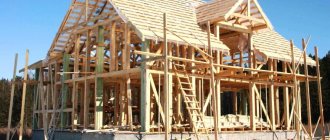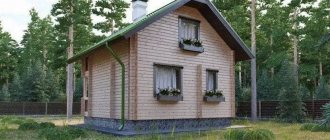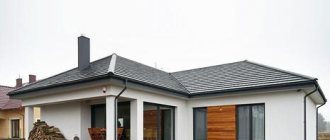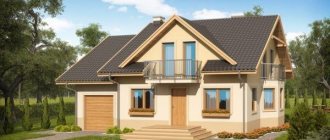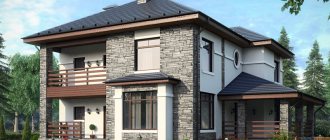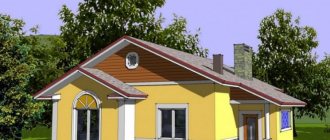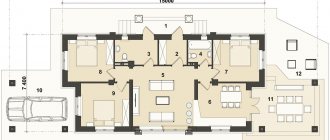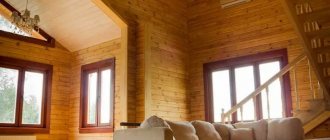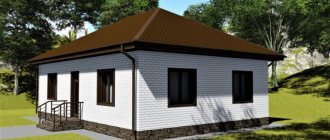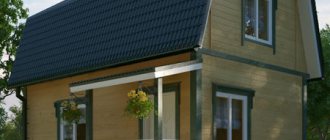The construction of frame houses is very popular in our country. Thanks to this technology, you can acquire your own home in a short time and for little money. A 4 x 6 frame house with a built-on attic is considered very popular among developers planning to make a place for summer recreation on their 10-acre dacha plot.
Many developers want to save even more on construction and do the construction themselves. Let's figure out how easy it is to build frame houses on your own.
Project of a 4×6 frame house with an attic
Advantages of a frame house
- Minimum construction time. Some types of structures can be assembled in one week. On average, construction work takes up to four weeks.
- Small size and functionality. The 6x4 frame house is compact, making it possible to build it on a small plot. The compactness of housing does not affect its functionality. You will have at your disposal a comfortable living space with several rooms. There will be space on the site for a garden or vegetable garden.
- Excellent thermal insulation properties. Thanks to this, you can live in the house throughout the year.
- Nice exterior. The house will have an attractive appearance.
- Low cost. Construction of a frame house is cheaper than construction of other structures. Special equipment is not always used in the work.
- Ecological cleanliness. During construction, a metal or wooden frame is used. It itself is environmentally friendly. The main structural material is wood. In addition, wooden cladding, drywall, basalt fiber, lining and other materials that are not capable of harming the environment are used.
- Possibility of free planning. You choose the location and size of the rooms yourself.
- Saving money and space when laying communications. They hide under the casing.
If you add a 6x4 balcony and a terrace to your house project, you can drink your morning coffee in the fresh air. Source 9dach.ru
The frame house is unpretentious in terms of foundation. It has light walls. At the same time, the house is completely protected from the penetration of cold and moisture. It keeps you cool in summer. This is comfortable housing for a small family.
Frame disadvantages
For some reason, it is believed that frame-panel country houses have a low level of strength. If compared with stone or brick buildings, they will definitely be inferior to them.
But there is no reason to worry that the house will be “blown away” by a strong wind or carried away by a hurricane. If the construction technology is strictly followed, then your home will not be afraid of any disasters.
The disadvantage of a house is that it does not “breathe”: building materials treated and impregnated with various compounds to improve their performance qualities are less breathable. This problem can easily be eliminated by installing a reliable ventilation system. It will do a great job of circulating fresh air.
Poor sound insulation is also often blamed on small country frame houses. The use of additional soundproofing materials significantly helps to improve the situation with the sound permeability of housing.
If we compare the pros and cons of building frame country houses , then the benefits of this construction event will be obvious. Where to start?
Projects and layout options for a 6x4 frame house
A frame house can be one- or two-story. Most people prefer a 6 by 4 two-story house; the layout of such housing provides more opportunities for creating comfort and coziness. As a rule, the second floor is attic. Its main advantage is its high ceiling. A staircase leads to the second floor, which can be one or two flights. A terrace can be attached to the structure. It increases the convenience and aesthetics of the exterior. The terrace may have a fence made of planed timber, solid lining, balusters, etc. The terrace may have a separate roof, or it may be located under the attic floor. The second option allows you to increase the area of the attic floor.
The total area of the house will be at least 35 m2. On the ground floor you can place a kitchen, a bathroom and one room, for example, a living room. An option without a bathroom is possible. Then the usable area of the rooms will be larger. In addition to two rooms, there is a staircase on the ground floor. The space around it can be considered a hall.
The layout of the rooms, in most cases, looks something like this Source dom-steny.ru
The bedroom is most often located on the attic floor. Also, the attic can be divided into two rooms. In this case, you can arrange a living room and a bedroom here. It is possible to equip two bedrooms. The space around the stairs will act as a small corridor.
There are a lot of options for planning a two-story house. You can show your imagination and create comfortable housing for the whole family.
During construction, you can use a standard design. However, it is better to develop it individually. When drawing up a project, you need to take into account the number of family members, their needs and financial capabilities. An individual project of a 4 by 6 house allows you to build the most comfortable housing, taking into account all the wishes of the customer.
See also: Catalog of frame house projects presented at the Low-Rise Country exhibition.
Availability of additional premises
For a 4x4 dacha, additional equipment can be provided. A small house can be expanded with an attic or terrace.
The complete set of a 4 by 4 country house includes the materials necessary for the construction of the structure. Let us highlight the main stages of construction:
- construction of the foundation;
- base;
- walls and partitions;
- roof;
- insulation;
- finishing;
- installation of windows and doors.
Attic
A country house made of timber with an attic allows you to expand the usable area. Under the roof you can equip an additional place for rest or storage. If it is possible to build an attic, then there is a need to insulate the roof. Ondulin roofing provides sound and thermal insulation of the room under the roof. The attic creates additional load on the load-bearing walls and foundation. Therefore, it is recommended to use ready-made projects tied to the soil on the site.
Terrace
The design of a country house with a terrace creates additional places for relaxation. Buildings with a terrace allow comfortable accommodation not only for the owners, but also for the guests. The choice of terrace depends on the size of the land plot and the design of the structure. The terrace can be located on one side of the building or be angular, covering two sides. An additional storage shed for equipment can be located on the large terrace.
Construction stages
- Construction of the foundation. Frame buildings are lightweight. Non-reinforced foundations are suitable for them.
- Frame installation. As mentioned above, the frame can be metal or wood. The metal frame is considered more reliable. However, it increases construction costs. In addition, a metal frame requires a stronger foundation. On the street side, the frame is covered with boards or clapboards.
The frame of the building is sheathed with boards, after which the exterior finishing is carried out. Source ap-home.ru
- Floor installation. It consists of several layers. The first layer is roofing felt. It is laid on the foundation. In some cases, an additional building level may be necessary. Insulation is laid between the joists. And only then the rough or finishing material is applied. These can be boards, linoleum, parquet, etc.
- Wall installation. It is preferable to build them on a subfloor. When constructing them, you need to take into account the location of the windows. They occupy approximately 18% of the wall covering. As for windows, it is better to choose double glazing. It will increase the heat and sound insulation properties of the house.
- Roof construction. The roof must be installed immediately after the walls are erected. Otherwise, they may be damaged by precipitation. Roofing material is selected depending on the wishes of the customer.
Insulation
If the house will be used as a summer house, then insulation is not such an important issue. But for year-round use, a frame house must be insulated. The building is erected from vertical posts, between which horizontal bars are attached. Hollow cells form between them. You can put insulation in them.
A simple 6x4 house with an attic - simple but cozy Source glezer.ru
Walls can also be insulated outside and inside. The second option is less rational. A 6x4 house does not have large dimensions anyway. Insulation inside the rooms will hide the usable space. On the outside, the insulation will perform not only its main function. It can also be used as a decorative material. You can choose polystyrene foam or expanded clay as insulation for the walls and floors inside. The second one has better performance, but it is more expensive. For exterior decoration, you can choose lining or siding.
The insulation inside and outside is attached to the sheathing. From the inside it is covered with a waterproofing film. Be sure to leave a small ventilation gap. The insulation is hemmed with a layer of vapor barrier. Then the finishing material is attached to the sheathing.
DIY country house: diagrams and instructions
After purchasing a country plot for a summer residence, the question of how to build a country house with your own hands becomes urgent. Well, building it yourself is quite possible, unless, of course, you are planning a huge “palace” that requires the involvement of construction equipment and a team of professionals.
DIY country house
Usually compact buildings are chosen for a dacha, but, nevertheless, the house must have everything necessary for relaxation - rooms, a kitchen, a veranda. The latter will become a favorite place for the whole family to hang out in the evening. It is very important to make the country house cozy and comfortable, so you need to think through all the nuances of its arrangement.
The optimal material for a country house building is wood, and the principle of construction is a frame structure.
Of course, the first thing that will need to be done is to decide on the location and size of the building, draw up a project, and plan further work.
Small country house project
The size of the future home largely depends on the area of the dacha plot, the number of family members and the financial capabilities of the owners. If you plan correctly, draw up a successful project and choose inexpensive but high-quality material for construction, you can save space, money and work time.
In any case, the first steps are drawing up a project
Most often, a country house has a size of 5.0 × 6.0 or 4.0 × 6.0 m. Larger buildings are erected much less frequently, and mainly in cases where they are planned to be used year-round. But this, most likely, will not be a country house, but a full-fledged country house.
The layout of the house may have to be carried out on the basis of requirements that can be established by the board of the gardening association, therefore, when purchasing a plot, you need to find out about such nuances in advance. The following distances are most often required:
- The house must be installed at a distance of 3 meters from the border of the neighboring plot, and from the fence separating the plot from the general passage (street) - 5 meters.
- In order to ensure fire safety, a stone house is placed at a distance of at least six meters from another stone building, and ten meters from a wooden one. If the house is wooden, then it should be installed at a distance of no closer than 15 meters from another wooden building.
- To prevent the house from blocking neighboring buildings from sunlight, if it is placed on the eastern, southern or western side of the site, it is located at a distance from another residential building at least equal to its height.
Usually, to install a country house, the highest place on the site is chosen, in which water will not collect when snow melts or from heavy rains. Increased humidity under the house will never benefit any building material, but it will always have a negative impact on the overall strength and durability of the structure.
Most often, the following construction technologies are chosen for the construction of country houses: frame-panel construction, log houses, walls made of blocks or bricks.
For summer cottages, designs of one-story houses with closed or open verandas or terraces are predominantly chosen. Often a building has an attic space used for storing garden tools and other things that seem unnecessary in everyday use, but which can always be useful in the country. However, it also happens that in some projects there are no attic floor beams at all, and then the roof slopes simultaneously serve as a ceiling.
This miniature house has no attic at all.
If the family is large, and the area of the plot is not as large as we would like, then you can plan a two-story house that takes up very little space at the base. In this case, the first floor can be used as a living room, terrace and kitchen, and on the second floor you can arrange cozy sleeping areas for the whole family.
Country house with a small attic
It is not at all necessary to erect a full-fledged second floor in a dacha building, since its role can be perfectly fulfilled by an attic superstructure. By decorating it with natural materials, you can create a wonderful, healthy country atmosphere.
Country houses are mainly used during the warm period of the year, starting with the arrival of spring and ending in autumn. Therefore, they do not require enhanced insulation of walls and roofs, but devices for heating the premises must still be provided - in case of cold nights or a drop in temperature during unstable weather. Typically, electrical appliances are used as heaters, for example, convectors or infrared film emitters, but sometimes owners even prefer to install fireplaces or cast iron heating and cooking stoves.
By the way, if you plan to build a real fireplace or brick stove, then they must be included in the project being compiled.
There are also ready-made versions of country houses, sold complete in disassembled form, which simply need to be delivered to the site and assembled. Any such set of parts must be accompanied by detailed instructions, which outline the procedure for carrying out the work, basic technological techniques and connection diagrams of individual elements and assemblies.
Prefabricated house built from a ready-made set of parts and components
For the owner of the site, who has basic construction skills, it will not be difficult to assemble such a country house on his own. The main advantage of this option is that the kit often already includes everything necessary for the building’s electrical network, its ventilation system, and even for installing the water supply.
Video: a small, neat country house that lives up to its name
What type of house to choose?
Having decided on the approximate plan of the future house, you need to choose the material for its construction. This choice will determine not only the appearance of the building itself, but also the comfort of staying in it, as well as the costs of its construction.
- The traditional material for a country house is wood, which will create a favorable microclimate in it, filling it with the smells of the forest. A wooden house can be built using a frame method, from timber or logs. The disadvantage of wooden buildings is considered to be the high fire hazard of the material.
Wood is probably the best option for a country house.
However, wooden houses have always been built, and many of them have stood for centuries. Today, there are special fire-retardant impregnations on sale that significantly reduce the risk of fire in wooden buildings. And in general - the most important thing here is not the material, but the human factor - it is people’s neglect of basic fire safety requirements that in the overwhelming majority of cases becomes the cause of fire.
- The construction of a brick structure will cost much more, but it can with good reason be called a full-fledged house, which can be used not only in the summer, but also, if necessary, in the winter, if you install a stove in it. Brick buildings are much less susceptible to fire and, with high-quality masonry, will last a very long time. Their disadvantages include a more complex and lengthy construction process, requiring special skills, and the high price of materials.
A small dacha built of brick.
This category of buildings also includes block houses made of expanded clay concrete, aerated concrete, foam concrete, etc.
- Very often, different materials are used when building a country house. For example, a house is built from wood, but on a foundation made of concrete, brick or blocks.
Wooden house on a brick columnar foundation
This option can be called optimal, since a foundation made of moisture-resistant materials will create optimal conditions for the construction of walls made of wood, thus becoming a reliable foundation for the house.
It is this last option that is worth considering, since it is the most popular of all types of country houses.
Stages of construction of a country house
Materials for building a country house
If you don’t want to bother with calculations, then it’s better to purchase a prefabricated model of a house that has a certain area, for which you only need to prepare a place.
In all other cases, you will need to purchase building materials. Their type, size, volume, total number - all depending on the size of the planned building, which is determined by the project.
Prices for various types of timber
timber
Foundation material
For any type of foundation you will need the following materials:
— sand, crushed stone, cement;
- third-grade board and timber for formwork;
- brick or concrete blocks;
— waterproofing material (roofing felt);
— expanded clay of the middle fraction.
Wall and roof material
Since wood was chosen for the construction of the walls, other materials will be selected based on this:
— bars and boards of different sizes, depending on the design parameters;
- fastening elements - nails, self-tapping screws, bolts, studs;
- corners of different configurations, metal plates - for fastening nodes;
— vapor barrier film;
— insulation — mineral wool, ecowool or expanded clay;
— to cover the roof, it is better to choose a lightweight material — ondulin or corrugated sheeting.
Once the installation location for the future house has been determined and the materials have been purchased, you can proceed to arranging the foundation. True, first you will have to decide on its type.
Country house foundation
Even when erecting such a small and light building as a wooden country house, you cannot do without a foundation. In this case, one of two types is ideal for these purposes - a columnar and strip foundation. Which one to choose depends on the preferences of the builder.
- A column foundation will be a less expensive option, as it will allow you to seriously save on building materials. In addition, such a foundation can be completed independently, without outside help, which will also save some money.
Columnar foundation with bottom frame bars
How to properly build a columnar version of the foundation can be found out in full detail by following this link to the corresponding page of our portal.
- To create a strip foundation, you will need not only a larger amount of materials, but also a fairly long period of time. This is not surprising - along the entire perimeter of the future house you will need to dig a trench, waterproof it, install a reinforcement structure, build formwork and fill the foundation pit with concrete. And after that, whether you like it or not, it will take another month until the filled tape completely hardens and gains brand strength.
Strip foundation
However, strip foundation is still very popular among individual developers. This option is convenient because it allows you to make a basement under the house, however, to do this, the foundation walls will have to be raised above the soil surface by 700 ÷ 800 mm. The structure of a strip foundation is described in detail in the article, which can be found on our portal by following the link provided.
If a columnar foundation is selected, then it is recommended to remove the top layer of soil by 150 ÷ 200 mm from the site, which will be located under the house and around it by 500 ÷ 600 mm. Then pour a 30 ÷ 40 mm layer of sand into the resulting pit, which should be compacted. A layer of medium-fraction crushed stone is laid on top of the sand cushion and is also compacted, and the remaining space must be filled with expanded clay of the middle fraction. All these procedures are done to ensure that small rodents cannot get close to the house. They cannot stand expanded clay (especially small clay), as it contains a large amount of dust and has a loose surface.
Fine expanded clay is an excellent rodent repellent
To protect the house from the penetration of large rodents or other uninvited guests from the animal world, it is advisable to cover the space under the house with a metal mesh with cells no larger than 10 mm.
Construction of a frame structure
For a country house, the best choice is a frame structure.
A frame house can be placed on either a columnar or strip foundation. Construction always starts from the base, which must be reliably waterproofed with two or three layers of laid roofing material.
- If the project includes a veranda, you must immediately separate its zone, over which a roof will be erected, but there will be no solid walls. To support the roof over the veranda, you can use the racks of the general wall frame. Another option is that the veranda will be attached to the house separately.
- Without exception, all wooden workpieces must be treated with antiseptic compounds and fire retardants. These impregnations will increase the wood's resistance to fire and rot, and will prevent the appearance of insect nests or colonies of microflora representatives - mold or fungus.
Laying and assembling the beams of the lower crown trim
- After the workpieces have received proper preparation and are completely dry, during construction, a lower frame (crown) is first made, which will be laid on the foundation and will subsequently be used to install the floor.
In order for the floor to be reliable, it is necessary to use high-quality timber of the required cross-section for the frame. If funds allow, then it is better to choose wooden elements not according to the “lower limit” of dimensions, but by placing a certain margin in their cross-section.
The table shows the optimal dimensions of timber for a frame house:
| Material and its purpose | Section size (in mm) |
| Bottom frame beam | 100×150 |
| Top frame beam | 100×100 |
| Beam for gable wall studs | 100×50 |
| Beam for side posts | 100×100 |
| Floor beams | 100×80 |
- The frame support beams are mounted on crown bars located along the perimeter of the foundation, at a distance of 600 ÷ 700 mm from each other. They are secured using corners or by inserting. If the elements are large in cross-section, they can additionally be fastened with metal brackets.
Connecting unit at the installation site of the vertical stand (optional)
- When the lower frame with support beams is ready, the wall frames are made. They can be assembled separately, and then, when finished, lifted and secured to the framing bars.
Installation of the wall frame
Another option is to raise the frame directly in place. For example, if a house is being built independently, without helpers, then it will be very difficult to lift the finished wall frame to the height of the frame alone, install it evenly and temporarily fix it until it is finally secured. This means that each of the bars will have to be placed separately.
- The size of the bars for the wall frame posts must be at least 100x100 mm, but it can also be mounted from boards with a cross-section of at least 50x150 mm.
The bars are secured to the lower frame using powerful corners that can hold them in a vertical position. It is best to use self-tapping screws rather than nails for fastening - the difference in price is not so significant, but the quality and reliability of the assembly is incomparably higher.
- When installing vertical racks, you need to immediately mark the location of the openings for windows and doors. It is best to leave the area where they are to be installed free in the frame, and install the part of the wall with the window opening separately.
Section of the frame with a window opening
Then, when the upper strapping block is installed and secured on all other vertical posts, the section with the window opening is fixed to the space left for it.
- All four walls are assembled in the same way. At the corners, the side posts are fastened together with corners, or instead of two separate ones, one common corner post is mounted. It is recommended to support it with diagonal struts on both sides - they will add rigidity to the entire wall structure.
Simplified assembly of frame walls with braces
- The doorway is installed in the frame immediately. It is reinforced with an additional rack, since a door suspended on hinges has a certain weight, which must be calmly supported by both the reinforced opening and the entire wall frame.
A doorway is left on one side of the frame
- If you plan to sheathe the frame from the outside with clapboard, then this is the next step. The sheathing will give the structure additional rigidity, which will allow the installation of the attic floor and roof truss system to continue.
Covering it with clapboard will give additional rigidity to the entire frame structure.
Installation of the floor can be carried out immediately after the outer cladding of the walls, but only if the roof is covered with a roof on the same day. It is highly undesirable for your freshly laid flooring to get wet if it rains unexpectedly at night. Therefore, it is better to first resolve the issue with the roof, and then calmly deal with all other construction activities inside the house.
Roof construction and roofing
Types of rafter systems
A few words need to be said about the types of rafter systems, since, moving on to the construction of the roof, it is necessary to have a general idea about this, to know which design is best to choose.
There are two types of rafter systems - hanging and layered.
Hanging system
The hanging rafter system is distinguished by the fact that it is installed only on external load-bearing walls and has no other supports. It is perfect for erecting over a small country house building. In order to lighten the load on the wooden walls and on the foundation, hanging rafters are fastened with ties.
Hanging rafter system
The hanging structure itself consists of a transverse beam, which also performs an overlapping function, and can simultaneously serve as a frame for lining the ceiling, as well as rafter legs that form the roof slopes.
Layered system
A layered system is installed if the house, in addition to external walls, has internal permanent partitions that will become additional support points. This scheme can also be used when constructing the roof of a country house, if it has a large area and its rooms are separated by walls built on the foundation.
Roofs made according to the layered scheme
When installing this system, the load on the load-bearing side walls becomes weaker, so it will be possible to use fewer retaining elements. It is perfect for attic structures that will be used as living quarters.
Floor beams
An important structural element is the floor beams.
The beams are laid exactly above the vertical posts of the wall frame. In order for them to fit tightly on the upper strapping belt, grooves are cut out at their edges. The size of the grooves can be calculated based on the formula shown in the figure.
Option for inserting floor beams into the upper crown (mauerlat)
The beams are secured to the frame structure of the walls using nails or self-tapping screws, and in addition they are sometimes fixed on both sides with metal corners.
Having completed the installation of the ceiling beams, you can proceed to building the roof truss system. For safety reasons, temporary plank flooring is laid on the floor beams to ensure comfortable movement along the attic plane during installation of the rafters.
Installation of the rafter system
Elements of the rafter system
The roof rafter system can be mounted using different sequences of fastening its elements:
- First option. It is necessary to fasten the outer pairs of rafter legs on the ground, then lift them onto the harness and install them ready-made on the gable walls of the house. And then connect them with a ridge beam, and mount the remaining pairs of rafters on it.
- Second option. To begin, install the middle posts along the gables, then fasten them with a ridge beam or board, onto which the rafters are then attached.
- Third option. In this case, pairs of rafter legs in their upper part are attached to each other with a ridge plate, and their lower side is fixed to the wall frame, which in this embodiment will act as a mauerlat.
The cross-section of beams or logs used for rafter legs must be strictly maintained - depending on the length of the rafters between two points of support, and depending on the pitch between adjacent pairs of rafters
| Maximum permissible rafter leg length (in mm) | Rafter spacing (in mm) | |||||||
| 1100 | 1400 | 1750 | 2100 | |||||
| Section of the rafter leg (in mm) | ||||||||
| bars with cross-section | logs Ø | bars with cross-section | logs Ø | bars with cross-section | logs Ø | bars with cross-section | logs Ø | |
| up to 3000 | 80×100 | 100 | 80×100 | 130 | 90×100 | 150 | 90×160 | 160 |
| up to 3600 | 80×130 | 130 | 80×160 | 160 | 80×180 | 180 | 90×180 | 180 |
| up to 4300 | 80×160 | 160 | 80×180 | 180 | 90×180 | 180 | 100×200 | 200 |
| up to 5000 | 80×180 | 180 | 80×200 | 200 | 100×200 | 200 | — | — |
| up to 5800 | 80×200 | 200 | 100×200 | 200 | — | — | — | — |
| up to 6500 | 100×200 | 200 | 120×220 | 240 | — | — | — | — |
It should be noted that the attachment point for the rafters in its lower part will depend on the angle at which they are fastened to the ridge and how long they are.
If the rafter is long enough and protrudes beyond the load-bearing walls, then a notch is cut out on it, with which it will be installed on the strapping beam (mauerlat). An example of such a notch is shown in the picture:
Cutting the rafters into the mauerlat
If the rafter ends at the edge of the load-bearing wall, then its lower edge is cut at a right angle to the Mauerlat, and the leg itself can be fixed to it using a special fastening plate, a sliding support, an angle, a bracket, nails or long screws.
Other options for attaching rafters to the upper crown
If the house is very small, then after securing the rafters to the frame, tying them with ridge beams or boards, you most likely will not have to install additional supporting elements.
Detailed information on the exact calculation of the rafter system can be obtained from a special publication on our portal by following the recommended link:
For installation of additional reinforcing elements of the rafter system, the material can be selected in accordance with the recommendations indicated in the table:
| Elements of the rafter system | Sectional size of timber or board (in mm) |
| Mauerlat beam | 100×100; 100×150; 150×150 |
| Struts | 100×200 |
| Runs | 100×100; 100×150; 100×200 |
| Puffs | 50×150 |
| Supporting crossbars of racks | 100×150; 100×200 |
| Racks | 100×100; 150×150 |
| Fills, boards for assembling the cornice box | 50×150 |
| Front and hem boards | 22÷25×100÷150 |
Prices for various types of fasteners for rafters
Rafter fasteners
Roofing system
After the rafters and additional elements form the roof slopes, you can proceed to the installation of the subsystem for the roof deck.
- The first thing that needs to be done on the outside of the roof, after installing the rafters, is to lay a vapor barrier film, securing it first with staples and then with counter-lattice strips on the rafters.
The film is laid perpendicular to the rafters, starting from the lower eaves of the roof. The overlap between two adjacent strips must be at least 200 mm.
Vapor barrier film flooring
Next, thin wooden slats are placed on top of the film on the rafters, which will fix the vapor barrier and create the necessary ventilation gap.
- The main batten is mounted perpendicular to the counter-lattice, onto which the roofing material will be attached. The installation step of the guides depends on the type and size of the sheets of roofing material.
If a soft roof is chosen to cover the roof, then instead of sheathing slats, the slopes are covered completely - with plywood, and then with waterproofing sheets of roofing felt, which are overlapped by 150 ÷ 200 mm and glued together with bitumen mastic. Another option is to use soft bitumen decorative tiles, which are laid using a similar technology.
By following this link, you can learn more about the stages of work on installing a soft roof :
- The following roofing materials are most often used for wooden houses (depending on the steepness of the roof slope).
| Roofing material | Roof slope | Weight (kg/sq.m) |
| Corrugated asbestos-cement sheets (8-wave slate) | from 1:10 to 1:2 | 11 ÷ 14 |
| Corrugated cellulose-bitumen sheets (ondulin) | from 1:10 and more | 6 ÷ 7 |
| Soft roofing (flexible tiles) | from 1:10 and more | 9 ÷ 15 |
| Galvanized sheets (metal profiles) | from 1: 4 and more | 3 ÷ 6,5 |
| Metal tiles | from 1:5 and more | 5 ÷ 7 |
- The selected roofing material is laid and secured onto the prepared base. The work starts from the cornice, and if the first row is laid from right to left, then all other rows are installed according to the same pattern.
Some types of roofing materials have a strictly specified installation pattern in direction, which cannot be changed. This must be indicated in the instructions supplied with them.
Also, for any type of sheet roofing material, the amount of overlap in the direction of the slope is determined (usually 150 ÷ 200 mm), and the number of waves (relief protrusions) in the horizontal direction, along the roof.
- Almost all roofing materials are secured to the sheathing using special nails or self-tapping screws with waterproofing gaskets.
Fastening the ondulin roof
- It is very important to correctly select and secure the ridge elements of the roof, otherwise it will leak at the first rain. Typically, the ridge element is selected from the same material as the covering of the roof slopes.
- Next, the eaves of the roof are finished - this can be done with wooden or plastic lining. Sometimes special plastic elements - soffits - are used for these purposes.
Lining the eaves overhang from below with soffits
- Then elements of the roof drainage system are installed on the wind board - funnels, gutters on brackets, pipes, etc.
Never overlook your drainage system
- Next, the gable sides of the rafter system are sheathed. Most often, wooden or plastic lining or even planed boards are used for this.
For the lining, a special profile is fixed around the perimeter of the pediment triangle, into which the prepared panels, cut at the desired angle, will be installed. Installation is usually done symmetrically - from the middle post to one side and then the other - then the cladding will be smooth and neat.
Roof gable cladding
By the way, you can also install the lining horizontally, in a herringbone pattern, or come up with a more complex pattern.
Detailed information about roof construction can be found in the article posted on our website by following the link.
Now, having completed the external finishing of the roof and being confident that rain will no longer get inside the country house, you can move on to installing windows and doors, insulation, flooring and wall cladding.
Installation of windows and doors
- Window frames are mounted in the frame openings left for them and leveled. For preliminary fixation when placing the frame, spacers made of wooden blocks or slats are installed between it and the opening bars.
Seal the gaps between the window and the frame.
Then, after checking the correct installation, the frames are attached to the wall frame with metal strips. The remaining gaps between the frame and frame bars are filled with polyurethane foam. After it dries, the excess is cut off, and platbands are installed around the windows on the outside of the wall, which will close the unsightly appearance of the gaps and give neatness to the overall appearance of the house.
- It is best to install the door together with the door frame, if it has sufficient rigidity. This will make it much easier to align the entire structure with the level in the wall doorway.
It is best to install the door as a block - together with the frame and leaf.
When exposing the door frame, if necessary, to achieve a clear vertical position, place wedges (inserts) from wooden slats. The door frame is secured to the frame in the same way as window frames, using metal strips, and the gap is filled with polyurethane foam.
Having installed all the windows and doors, you can proceed to installing the floor.
Installation and insulation of floors
Approximate structural diagram of a frame floor
To begin with, the temporary flooring from the boards (if there was one) is removed from the lower frame, and then you need to install the subfloor.
- To do this, cranial bars are nailed or screwed onto the frame supporting beams. They are necessary for laying transverse subfloor boards on them.
Beams with stuffed cranial bars
- Next, boards cut to exact size or plywood 8 ÷ 10 mm thick are laid on the skull blocks - this flooring will serve as a subfloor.
- The subfloor laid on top is covered with a hydro-steam-insulating film, which should cover both the load-bearing beams and the entire plane of the floor. Individual sheets of material are laid overlapping (by 150 ÷ 200 mm) and taped at the joints with waterproof tape.
Membrane and insulation
- Next, insulation material is laid or poured onto the vapor barrier film. If you do not want to have rodents as neighbors who like to live under the floor, then it is better to use expanded clay of medium or fine fraction, or ecowool, to insulate the floor - these toothy pests simply do not live in such materials.
Insulation of frame floors with expanded clay
- Another layer of film membrane is laid on top of the insulation, which is nailed to the supporting beams with staples. The installation principle is exactly the same as on a subfloor.
The floor is finished!
- The entire structure is then covered with thick plywood or wooden floorboards.
Prices for thermal insulation materials
Thermal insulation materials
Measures for additional thermal insulation
When the floor is completely ready, the walls of the house are insulated and sheathed from the inside. If the building will be used only in the warm season, then the insulation will still not hurt - it will work as an insulator of the premises from heating in extreme heat. Therefore, it is recommended to lay a thermal insulation layer not only in the walls, but also in the ceiling, and if it is missing, place insulation along the internal slopes of the roof.
Ceiling lining
- First, a vapor barrier material is attached to all walls and ceiling beams. Then the ceiling is covered with clapboard, plywood or plasterboard.
- After covering the ceiling, the walls are insulated. Insulation mats are laid between the frame posts. It is necessary to ensure that the mats fit as tightly as possible against the bars of the wall frame, so that there are no gaps left.
Walls insulated with mineral wool mats
This is why mineral wool is most often used as insulation - after being tightly laid between the studs, it will expand, completely filling the entire space. The material is usually selected so that the thickness of the mats and the thickness of the frame posts are the same.
- After this, all walls are again covered with vapor barrier film.
Walls before final cladding with clapboard or plasterboard
- The next step is covering the walls with wooden paneling, plywood or plasterboard. The latter, during subsequent decorative finishing of the walls, can be painted with water-based paint or covered with wallpaper.
Wall cladding inside the house
- Next, the attic floor is insulated, where the insulation is placed between the floor beams.
If the ceiling is sheathed on the side of the house with plasterboard or clapboard, then we must not forget that you cannot step on it, since the sheathing will not support the weight of a person. You must move carefully along the floor beams.
Insulation of the attic floor
- If the attic is planned to be used for storing various garden supplies, then a flooring made of boards or plywood with a thickness of at least 10 mm should be secured on top of the insulation on the floor beams.
- The finishing touches of the interior decoration will be the installation of platbands on windows and doors, ceiling and floor skirting boards and closing the corners with fittings.
Extensions to the house
The last stages of arranging a country house are installation work on the veranda and porch.
If a place is left in advance for the veranda on the frame lying on the foundation, then a board is laid on this space to cover the floor (material for open areas is used), a fence is installed and a canopy is mounted.
An example of a country house with a veranda
If the foundation is raised high enough above the ground, then a porch is also attached to the veranda.
Building a country house with your own hands is a completely doable task, but it will be quite difficult to do without helpers. Therefore, it is best to seek help from a knowledgeable craftsman who has experience in such work, will always give useful advice and show how to correctly install certain components in the structure of the house. You can “mobilize” your relatives and friends - it is possible that a knowledgeable person will be among them.
Video: building a country house using frame technology
Projects and layout of a 4x6 house
Wooden house 4x6 with an attic floor and a balcony Source dom-steny.ru
The shaped roof of the house will increase the space of the upper room Source dom-steny.ru
Layout of a 6x4 country house with an attic and veranda Source dom-steny.ru
Houses of the same type can be slightly transformed Source dan-stroi.ru
A terrace with columns and a non-standard roof make a small house presentable Source dom-steny.ru
Room layout: studio hall on the first floor and bedroom on the second Source vizada.ru
A country house can be like this: one floor and 2-3 small rooms Source domnomore.com
Video description
Frame houses.
What is a double volume frame? Construction of a frame house will cost at least 200,000 rubles. The cost depends on the footage. Examples:
- House with an area of 40 m2 without a terrace – 218,000 rubles
- House of 51 m2 with a terrace – 282,000 rubles
- House of 60 m2 with a terrace and balcony – 348,000 rubles
The maximum construction cost can reach a million rubles. It depends on the number of rooms, the presence of a bathroom, the materials used and many other factors. The price will be calculated when drawing up the project. You can build a comfortable and beautiful house in Moscow, depending on your financial capabilities.
Foundation
Construction of a house begins with laying the foundation. For frame houses, two types of foundations are usually used: strip and columnar (piles). The choice depends on the following conditions:
- Ground water level;
- Soil freezing level;
- Soil type;
- Weight of the house structure.
Before building a foundation, it is necessary to determine what elements and materials it will consist of. The dimensions of these elements, the method of reinforcement, the composition of the concrete solution. If a columnar foundation will be used, it is necessary to determine the distance between the pillars and their number, as well as the depth of driving these pillars.
